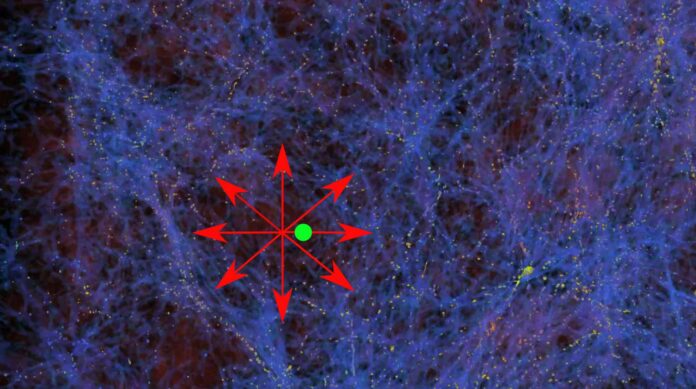In cosmology, the Hubble tension is one of the most contentious debated issues still being contested. Direct local Hubble observations show a statistically significant difference from the classic Lambda-Cold Dark Matter model of cosmology, whose parameters are tuned to fit the angular power spectrum of anisotropies in the cosmic microwave background (CMB).
The local universe is expanding ten percent quicker than anticipated. The universe would have to be 10% younger if the high local determination of H0 is accurate than if the lower CMB-based value is real, even though the cause of this tension is unknown.
Scientists from Bonn and St. Andrews Universities are developing a novel approach. They claim that the Hubble tension disappears by employing a different theory of gravity, and the difference in the measured values can be explained.
Galaxies drift apart as a result of the universe’s expansion. The pace at which they accomplish this is directly related to their distance from one another. Edwin Hubble, an American astronomer, was among the first to notice this connection.
Determining the distance between two galaxies is essential to calculate how fast two galaxies are moving away from each other. It also requires a constant by which this distance must be multiplied.
This is a critical cosmological parameter known as the Hubble-Lemaitre constant. One way to ascertain its value is to examine the farthest reaches of the cosmos. This translates into a speed of over 244,000 km/h for every distance traveled (one megaparsec is equivalent to a little over three million light-years).
Prof. Dr. Pavel Kroupa from the Helmholtz Institute of Radiation and Nuclear Physics at the University of Bonn said, “But you can also look at celestial bodies that are much closer to us – so-called category 1a supernovae, which are a certain type of exploding star. It is possible to determine the distance of a 1a supernova to Earth precisely. We also know that shining objects change color when they move away from us – and the faster they move, the stronger the change. This resembles an ambulance, whose siren sounds deeper as it moves away from us.”
“If we now calculate the speed of the 1a supernovae from their color shift and correlate this with their distance, we arrive at a different value for the Hubble-Lemaitre constant – namely just under 264,000 kilometers per hour per megaparsec distance. The universe, therefore, is expanding faster in our vicinity – that is, up to a distance of around three billion light years – than in its entirety. And that shouldn’t be the case.”
Scientists have noticed something interesting that might help explain a mystery. They think that Earth is in a part of space where there isn’t much matter, like an air bubble in a cake. But there’s more matter around the bubble. The idea is that the force of gravity from the surrounding matter pulls galaxies inside the bubble toward the edges of this space. Everything is moving because of the pull from the matter around us.
Dr. Indranil Banik from St. Andrews University said, “That’s why they are moving away from us faster than expected. The deviations could therefore, be explained by a local under-density.”
Another group of researchers has measured how fast a bunch of galaxies, located about 600 million light years away from us, are moving. Surprisingly, they found that these galaxies are moving away from us about four times faster than what the standard model of cosmology predicts.
This is because such under-densities or “bubbles” are not allowed in the usual model and shouldn’t be real. Instead, matter ought to be dispersed uniformly throughout space. But if that were true, explaining what factors cause the galaxies to accelerate to such an incredible pace would be challenging.
Kroupa said, “The standard model is based on a theory of the nature of gravity put forward by Albert Einstein. However, the gravitational forces may behave differently than Einstein expected.”
A computer simulation was conducted by scientists using a modified theory of gravity. This is known as “modified Newtonian dynamics” (MOND for short). Prof. Dr. Mordehai Milgrom, an Israeli physicist, proposed this MOND forty years ago. Even now, it is still regarded as an outsider theory.
Kroupa said, “In our calculations, however, MOND accurately predicts the existence of such bubbles.”
The Hubble tension would vanish if gravity behaved according to Milgrom’s theories: the universe’s expansion would actually be governed by a single constant, and the observable variations would result from anomalies in the distribution of matter.
Journal Reference:
- Sergij Mazurenko, Indranil Banik, Pavel Kroupa, and Moritz Haslbauer: Simultaneous solution to the Hubble tension and observed bulk flow within 250 ℎ−1 Mpc; Monthly Notices of the Royal Astronomical Society; DOI: 10.1093/mnras/stad3357
